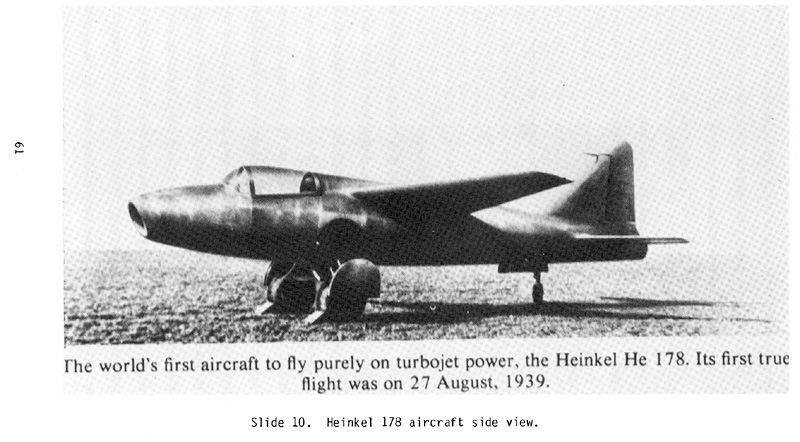- Heinkel He 178
infobox Aircraft
name =Heinkel He 178
type =Experimental prototype/Pioneer aircraft
manufacturer =Heinkel 
caption =
designer =
first flight =August 27 ,1939
introduced =
retired =
status =
primary user =
more users =
produced =
number built =
unit cost =
variants with their own articles =The
Heinkel He 178 was the world's firstaircraft to fly underturbojet power, and the first practical jet plane, the pioneering example of this type of aircraft. It was a private venture by the German Heinkel company in accordance with directorErnst Heinkel 's emphasis on developing technology for high-speed flight and first flew onAugust 27 ,1939 piloted byErich Warsitz . This had been preceded by a short hop three days earlier.Development
In 1936, a young engineer named
Hans von Ohain had taken out apatent on using the exhaust from agas turbine as a means of propulsion.He presented his idea to Heinkel, who agreed to help develop the concept. Von Ohain successfully demonstrated his first engine in 1937, and plans were quickly made to test a similar engine in an aircraft. The He 178 was designed around von Ohain's third engine design, the HeS 3, which burned
diesel fuel. The result was a small aircraft of conventional configuration and construction, with a metal fuselage and high-mounted wooden wings, with the characteristicGünter brothers elliptical trailing edge. The jet intake was in the nose, and the plane was fitted with tailwheel-styleundercarriage . The main landing gear was eventually intended to have been made retractable, but remained fixed in its "down" position throughout its flight trials.Photos showing a "straight wing" (straight-line-taper in the wing planform, for both the leading and trailing edge) He 178 were of the He 178 V2 second prototype, which never flew under power.
The aircraft was a success; however speeds were limited to 375mph at the proposed service altitude, and combat endurance was only 10 minutes. Its fall to official indifference was that Goering favoured the higher-developed
piston engine d fighters of the day which had already achieved higher performance standards, as opposed to investing more money into developing the jet engine. OnNovember 1 ,1939 , Heinkel arranged a demonstration of the jet for the "Reichsluftfahrtministerium " ("Reich Aviation Ministry", RLM), where bothErnst Udet andErhard Milch watched the aircraft perform. However, due to the conservative approach to aircraft design then favoured by both men, no official interest in the concept was shown. Nevertheless, Heinkel was undeterred, and decided to embark on the development of a twin-engined jet fighter, theHeinkel He 280 as a private venture using what had been learned from the He 178.The He 178 was placed in the "
Deutsches Technikmuseum " ("German Technical Museum") inBerlin , where it was destroyed in an air raid in 1943.pecifications (He 178)
aircraft specification
plane or copter?=plane
jet or prop?=jet
crew=One
length main=7.48 m
length alt=24 ft 6 in
span main=7.20 m
span alt=23 ft 3 in
height main=2.10 m
height alt=6 ft 10 in
area main=9.1 m²
area alt=98 ft²
empty weight main=1,620 kg
empty weight alt=3,572 lb
loaded weight main=
loaded weight alt=
max takeoff weight main=1,998 kg
max takeoff weight alt=4,405 lb
more general=
engine (jet)=HeS 3
type of jet=turbojet
number of jets=1
thrust main=4.4 kN
thrust alt=992 lbf
max speed main=598 km/h
max speed alt=375 mph
range main=200 km
range alt=125 mi
ceiling main=
ceiling alt=
climb rate main=
climb rate alt=
loading main=
loading alt=
thrust/weight=
armament=ee also
aircontent
related=similar aircraft=
*Gloster E.28/39
sequence=lists=
*List of World War II military aircraft of Germany
*List of military aircraft of Germany
*List of WW2 Luftwaffe aircraft prototype projects
*List of World War II jet aircraft
see also=
Wikimedia Foundation. 2010.
